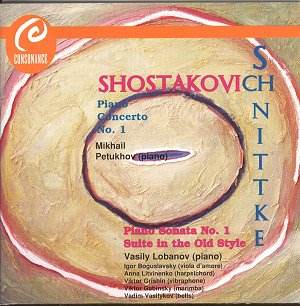Shostakovich’s First Piano Concerto is too well-known
to deserve any particular comments. Suffice it to say that this wonderful
piece is a superb example of the young composer’s mastery and imagination,
as well as of the often bitter-sweet irony imbuing much of his music.
The present performance is quite good though it takes a few minutes
to catch fire. The uncredited trumpet player is excellent.
At a times when modern music was anathema to the Soviet
regime, Schnittke often experimented many different techniques when
writing film scores (several for cartoons). Other films, such as Adventures
of a Dentist (1965) and Sport, Sport, Sport (1970), gave
him opportunities for unashamed pastiche. The Suite in Old Style
(1972, and not 1977 as mentioned on the back cover) was compiled from
parts of the above films. Schnittke incidentally confessed to feel uneasy
about it "because [he] felt as if it was not written by [him]".
True, it is almost impossible to think of Schnittke when listening to
this unashamedly jolly pastiche, even knowing that many of his earlier
works incorporated some pastiche elements in their polystylism. Originally,
the suite was for violin and piano (or harpsichord) and is often recorded
in this particular version; but there also exists a version for small
orchestra by Vladimir Spivakov and Mikhail Milman (once available on
RCA RD 60370), as well as the one under review for viola d’amore, harpsichord
and mallet instruments of which even expert Schnittke scholars seem
to be completely unaware. This one is quite entertaining; but, whatever
the version, this is a slight piece of little significance.
Schnittke’s Piano Sonata of 1987 is quite
another affair. Not only has the composer cast off his customary polystylism,
but he imparted the music with a darker, more introvert character. (It
was actually written after the Viola Concerto and the First Cello Concerto,
and just before the intense, Mahlerian Fifth Symphony.) The music, tense,
dramatic, sometimes ironic as in the second movement, is much more serious,
conveying some intense, personal emotions. A major work by any count,
still underrated and probably misunderstood; and an excellent performance
by Vasily Lobanov who gave the work’s first Russian performance.
Now, this is a curious release for, besides the fine
performances, there is really very little justification for bringing
these disparate works together. The 1989 recordings, probably made for
broadcast, still sound quite well. So, it is up to you to decide whether
such a programme is likely to appeal to you or not.
Hubert Culot


